Distinguishing Contracts: Service vs. For Service in Employment Law
VerifiedAdded on 2020/02/24
|10
|3233
|123
Essay
AI Summary
This essay provides a comprehensive analysis of the legal distinctions between a contract of service (employment) and a contract for service (independent contractor). It begins by highlighting the confusion surrounding the differentiation and emphasizes the importance of common law in defining these relationships. The essay explores the evolution of the 'control test' and its limitations, introducing the multi-factor approach used by courts. Key case studies, including Performing Right Society Ltd v Mitchell and Booker (Palais de Danse) Ltd, Stevens v Brodribb Sawmilling Co Pty Ltd, Hollis v Vabu, and Sweeney v Boylan Nominees Pty Ltd, are examined to illustrate the application of these principles. The discussion extends to the test of economic dependence, offering a nuanced understanding of the factors considered in determining whether an individual is an employee or an independent contractor. The essay provides a detailed overview of the legal landscape, offering valuable insights into employment law and the complexities of contract classification.
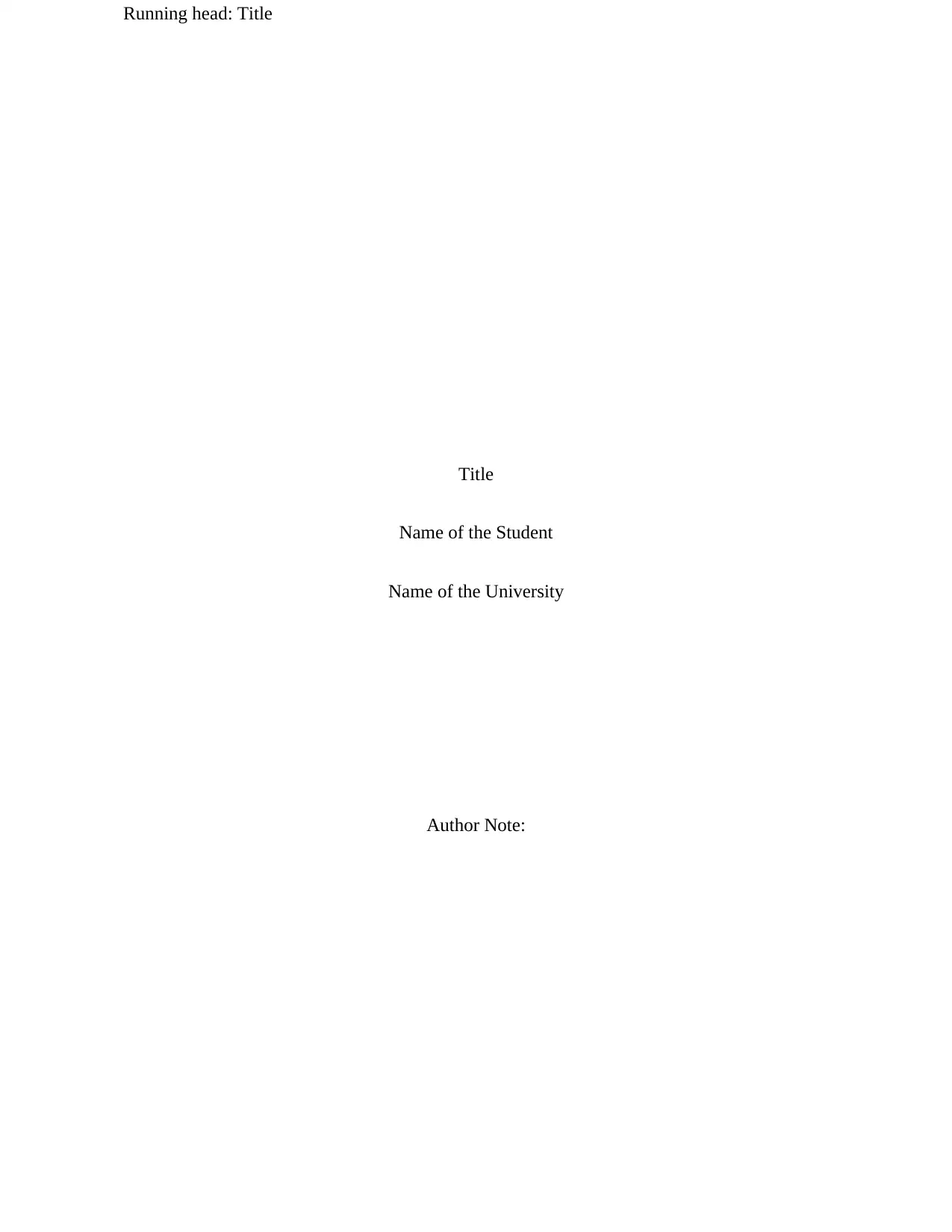
Running head: Title
Title
Name of the Student
Name of the University
Author Note:
Title
Name of the Student
Name of the University
Author Note:
Paraphrase This Document
Need a fresh take? Get an instant paraphrase of this document with our AI Paraphraser
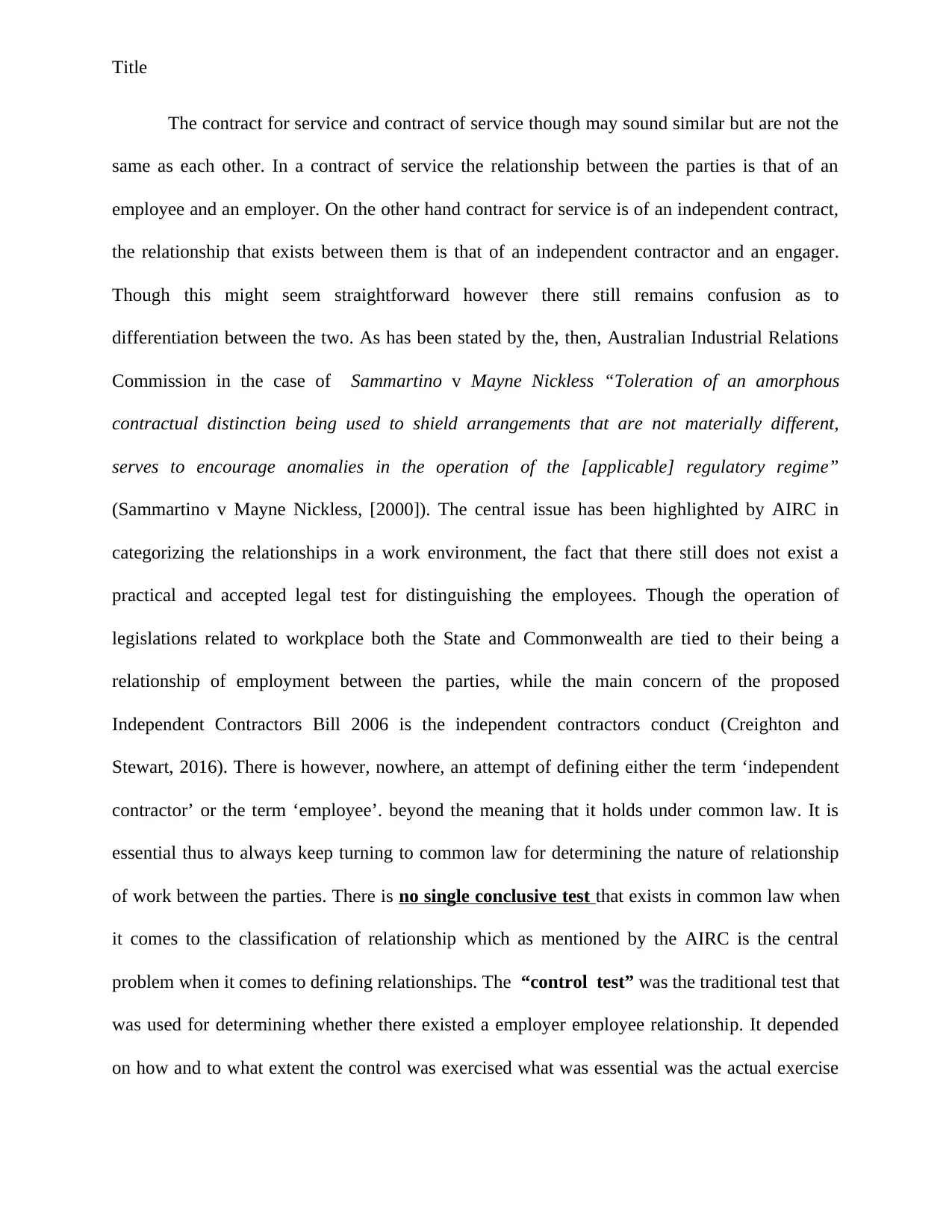
Title
The contract for service and contract of service though may sound similar but are not the
same as each other. In a contract of service the relationship between the parties is that of an
employee and an employer. On the other hand contract for service is of an independent contract,
the relationship that exists between them is that of an independent contractor and an engager.
Though this might seem straightforward however there still remains confusion as to
differentiation between the two. As has been stated by the, then, Australian Industrial Relations
Commission in the case of Sammartino v Mayne Nickless “Toleration of an amorphous
contractual distinction being used to shield arrangements that are not materially different,
serves to encourage anomalies in the operation of the [applicable] regulatory regime”
(Sammartino v Mayne Nickless, [2000]). The central issue has been highlighted by AIRC in
categorizing the relationships in a work environment, the fact that there still does not exist a
practical and accepted legal test for distinguishing the employees. Though the operation of
legislations related to workplace both the State and Commonwealth are tied to their being a
relationship of employment between the parties, while the main concern of the proposed
Independent Contractors Bill 2006 is the independent contractors conduct (Creighton and
Stewart, 2016). There is however, nowhere, an attempt of defining either the term ‘independent
contractor’ or the term ‘employee’. beyond the meaning that it holds under common law. It is
essential thus to always keep turning to common law for determining the nature of relationship
of work between the parties. There is no single conclusive test that exists in common law when
it comes to the classification of relationship which as mentioned by the AIRC is the central
problem when it comes to defining relationships. The “control test” was the traditional test that
was used for determining whether there existed a employer employee relationship. It depended
on how and to what extent the control was exercised what was essential was the actual exercise
The contract for service and contract of service though may sound similar but are not the
same as each other. In a contract of service the relationship between the parties is that of an
employee and an employer. On the other hand contract for service is of an independent contract,
the relationship that exists between them is that of an independent contractor and an engager.
Though this might seem straightforward however there still remains confusion as to
differentiation between the two. As has been stated by the, then, Australian Industrial Relations
Commission in the case of Sammartino v Mayne Nickless “Toleration of an amorphous
contractual distinction being used to shield arrangements that are not materially different,
serves to encourage anomalies in the operation of the [applicable] regulatory regime”
(Sammartino v Mayne Nickless, [2000]). The central issue has been highlighted by AIRC in
categorizing the relationships in a work environment, the fact that there still does not exist a
practical and accepted legal test for distinguishing the employees. Though the operation of
legislations related to workplace both the State and Commonwealth are tied to their being a
relationship of employment between the parties, while the main concern of the proposed
Independent Contractors Bill 2006 is the independent contractors conduct (Creighton and
Stewart, 2016). There is however, nowhere, an attempt of defining either the term ‘independent
contractor’ or the term ‘employee’. beyond the meaning that it holds under common law. It is
essential thus to always keep turning to common law for determining the nature of relationship
of work between the parties. There is no single conclusive test that exists in common law when
it comes to the classification of relationship which as mentioned by the AIRC is the central
problem when it comes to defining relationships. The “control test” was the traditional test that
was used for determining whether there existed a employer employee relationship. It depended
on how and to what extent the control was exercised what was essential was the actual exercise
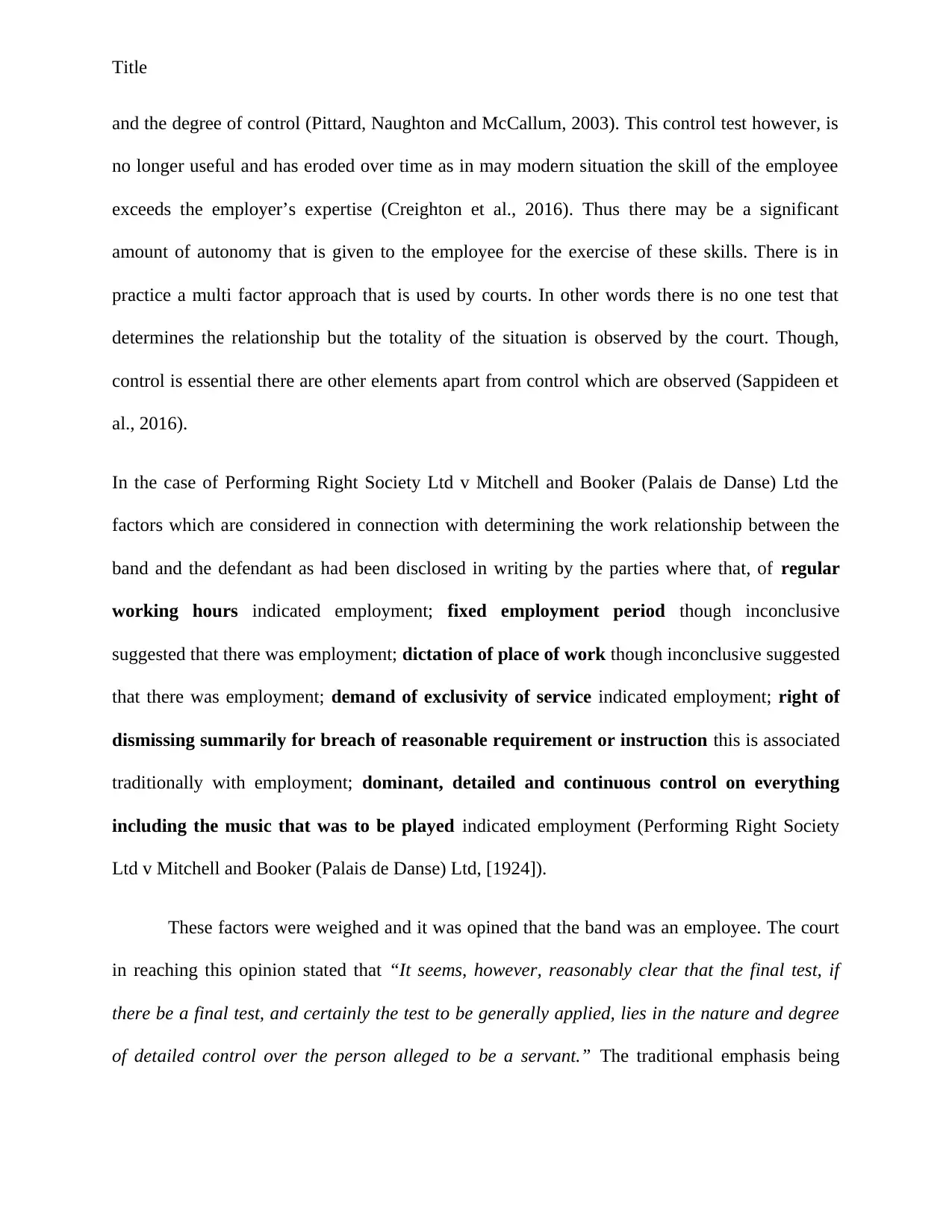
Title
and the degree of control (Pittard, Naughton and McCallum, 2003). This control test however, is
no longer useful and has eroded over time as in may modern situation the skill of the employee
exceeds the employer’s expertise (Creighton et al., 2016). Thus there may be a significant
amount of autonomy that is given to the employee for the exercise of these skills. There is in
practice a multi factor approach that is used by courts. In other words there is no one test that
determines the relationship but the totality of the situation is observed by the court. Though,
control is essential there are other elements apart from control which are observed (Sappideen et
al., 2016).
In the case of Performing Right Society Ltd v Mitchell and Booker (Palais de Danse) Ltd the
factors which are considered in connection with determining the work relationship between the
band and the defendant as had been disclosed in writing by the parties where that, of regular
working hours indicated employment; fixed employment period though inconclusive
suggested that there was employment; dictation of place of work though inconclusive suggested
that there was employment; demand of exclusivity of service indicated employment; right of
dismissing summarily for breach of reasonable requirement or instruction this is associated
traditionally with employment; dominant, detailed and continuous control on everything
including the music that was to be played indicated employment (Performing Right Society
Ltd v Mitchell and Booker (Palais de Danse) Ltd, [1924]).
These factors were weighed and it was opined that the band was an employee. The court
in reaching this opinion stated that “It seems, however, reasonably clear that the final test, if
there be a final test, and certainly the test to be generally applied, lies in the nature and degree
of detailed control over the person alleged to be a servant.” The traditional emphasis being
and the degree of control (Pittard, Naughton and McCallum, 2003). This control test however, is
no longer useful and has eroded over time as in may modern situation the skill of the employee
exceeds the employer’s expertise (Creighton et al., 2016). Thus there may be a significant
amount of autonomy that is given to the employee for the exercise of these skills. There is in
practice a multi factor approach that is used by courts. In other words there is no one test that
determines the relationship but the totality of the situation is observed by the court. Though,
control is essential there are other elements apart from control which are observed (Sappideen et
al., 2016).
In the case of Performing Right Society Ltd v Mitchell and Booker (Palais de Danse) Ltd the
factors which are considered in connection with determining the work relationship between the
band and the defendant as had been disclosed in writing by the parties where that, of regular
working hours indicated employment; fixed employment period though inconclusive
suggested that there was employment; dictation of place of work though inconclusive suggested
that there was employment; demand of exclusivity of service indicated employment; right of
dismissing summarily for breach of reasonable requirement or instruction this is associated
traditionally with employment; dominant, detailed and continuous control on everything
including the music that was to be played indicated employment (Performing Right Society
Ltd v Mitchell and Booker (Palais de Danse) Ltd, [1924]).
These factors were weighed and it was opined that the band was an employee. The court
in reaching this opinion stated that “It seems, however, reasonably clear that the final test, if
there be a final test, and certainly the test to be generally applied, lies in the nature and degree
of detailed control over the person alleged to be a servant.” The traditional emphasis being
⊘ This is a preview!⊘
Do you want full access?
Subscribe today to unlock all pages.

Trusted by 1+ million students worldwide
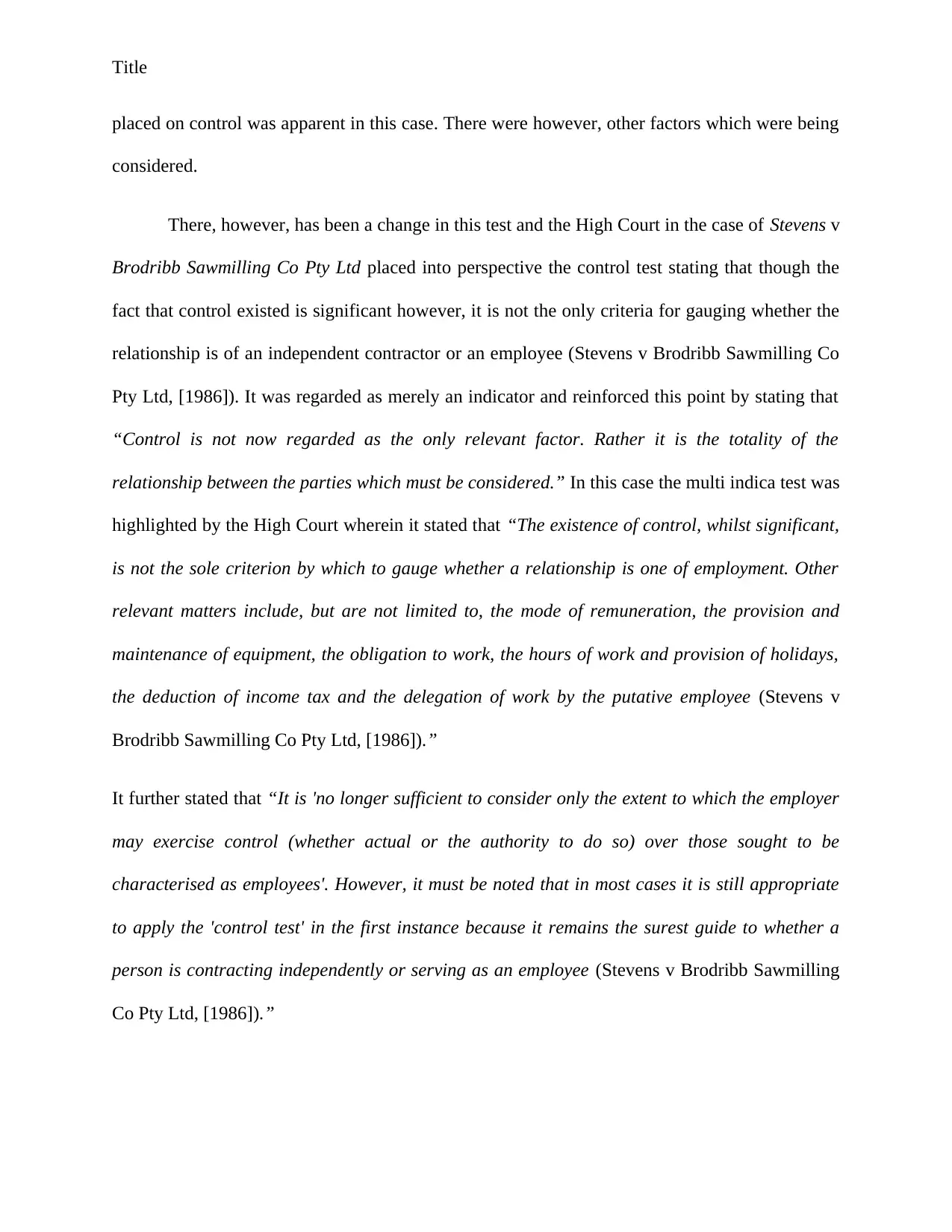
Title
placed on control was apparent in this case. There were however, other factors which were being
considered.
There, however, has been a change in this test and the High Court in the case of Stevens v
Brodribb Sawmilling Co Pty Ltd placed into perspective the control test stating that though the
fact that control existed is significant however, it is not the only criteria for gauging whether the
relationship is of an independent contractor or an employee (Stevens v Brodribb Sawmilling Co
Pty Ltd, [1986]). It was regarded as merely an indicator and reinforced this point by stating that
“Control is not now regarded as the only relevant factor. Rather it is the totality of the
relationship between the parties which must be considered.” In this case the multi indica test was
highlighted by the High Court wherein it stated that “The existence of control, whilst significant,
is not the sole criterion by which to gauge whether a relationship is one of employment. Other
relevant matters include, but are not limited to, the mode of remuneration, the provision and
maintenance of equipment, the obligation to work, the hours of work and provision of holidays,
the deduction of income tax and the delegation of work by the putative employee (Stevens v
Brodribb Sawmilling Co Pty Ltd, [1986]).”
It further stated that “It is 'no longer sufficient to consider only the extent to which the employer
may exercise control (whether actual or the authority to do so) over those sought to be
characterised as employees'. However, it must be noted that in most cases it is still appropriate
to apply the 'control test' in the first instance because it remains the surest guide to whether a
person is contracting independently or serving as an employee (Stevens v Brodribb Sawmilling
Co Pty Ltd, [1986]).”
placed on control was apparent in this case. There were however, other factors which were being
considered.
There, however, has been a change in this test and the High Court in the case of Stevens v
Brodribb Sawmilling Co Pty Ltd placed into perspective the control test stating that though the
fact that control existed is significant however, it is not the only criteria for gauging whether the
relationship is of an independent contractor or an employee (Stevens v Brodribb Sawmilling Co
Pty Ltd, [1986]). It was regarded as merely an indicator and reinforced this point by stating that
“Control is not now regarded as the only relevant factor. Rather it is the totality of the
relationship between the parties which must be considered.” In this case the multi indica test was
highlighted by the High Court wherein it stated that “The existence of control, whilst significant,
is not the sole criterion by which to gauge whether a relationship is one of employment. Other
relevant matters include, but are not limited to, the mode of remuneration, the provision and
maintenance of equipment, the obligation to work, the hours of work and provision of holidays,
the deduction of income tax and the delegation of work by the putative employee (Stevens v
Brodribb Sawmilling Co Pty Ltd, [1986]).”
It further stated that “It is 'no longer sufficient to consider only the extent to which the employer
may exercise control (whether actual or the authority to do so) over those sought to be
characterised as employees'. However, it must be noted that in most cases it is still appropriate
to apply the 'control test' in the first instance because it remains the surest guide to whether a
person is contracting independently or serving as an employee (Stevens v Brodribb Sawmilling
Co Pty Ltd, [1986]).”
Paraphrase This Document
Need a fresh take? Get an instant paraphrase of this document with our AI Paraphraser
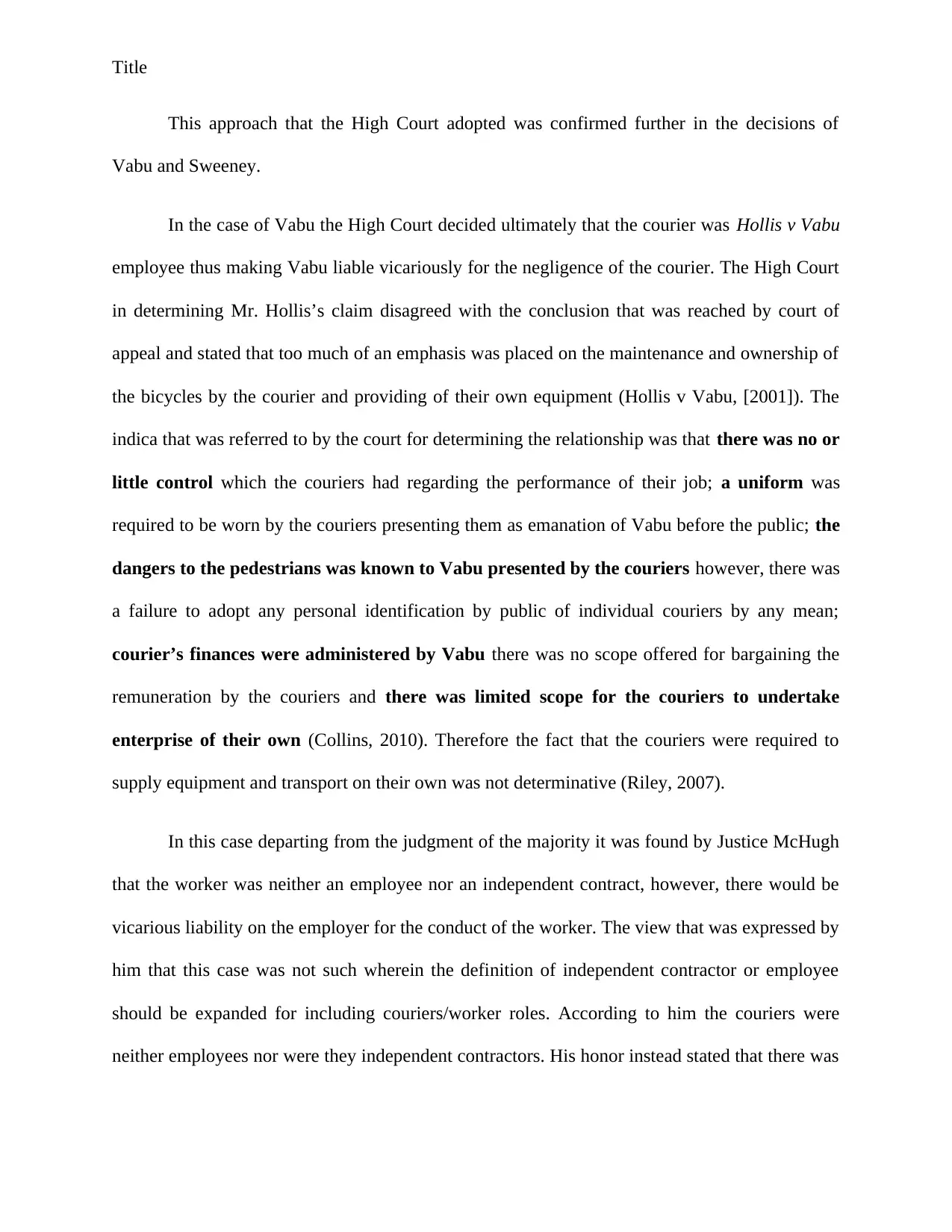
Title
This approach that the High Court adopted was confirmed further in the decisions of
Vabu and Sweeney.
In the case of Vabu the High Court decided ultimately that the courier was Hollis v Vabu
employee thus making Vabu liable vicariously for the negligence of the courier. The High Court
in determining Mr. Hollis’s claim disagreed with the conclusion that was reached by court of
appeal and stated that too much of an emphasis was placed on the maintenance and ownership of
the bicycles by the courier and providing of their own equipment (Hollis v Vabu, [2001]). The
indica that was referred to by the court for determining the relationship was that there was no or
little control which the couriers had regarding the performance of their job; a uniform was
required to be worn by the couriers presenting them as emanation of Vabu before the public; the
dangers to the pedestrians was known to Vabu presented by the couriers however, there was
a failure to adopt any personal identification by public of individual couriers by any mean;
courier’s finances were administered by Vabu there was no scope offered for bargaining the
remuneration by the couriers and there was limited scope for the couriers to undertake
enterprise of their own (Collins, 2010). Therefore the fact that the couriers were required to
supply equipment and transport on their own was not determinative (Riley, 2007).
In this case departing from the judgment of the majority it was found by Justice McHugh
that the worker was neither an employee nor an independent contract, however, there would be
vicarious liability on the employer for the conduct of the worker. The view that was expressed by
him that this case was not such wherein the definition of independent contractor or employee
should be expanded for including couriers/worker roles. According to him the couriers were
neither employees nor were they independent contractors. His honor instead stated that there was
This approach that the High Court adopted was confirmed further in the decisions of
Vabu and Sweeney.
In the case of Vabu the High Court decided ultimately that the courier was Hollis v Vabu
employee thus making Vabu liable vicariously for the negligence of the courier. The High Court
in determining Mr. Hollis’s claim disagreed with the conclusion that was reached by court of
appeal and stated that too much of an emphasis was placed on the maintenance and ownership of
the bicycles by the courier and providing of their own equipment (Hollis v Vabu, [2001]). The
indica that was referred to by the court for determining the relationship was that there was no or
little control which the couriers had regarding the performance of their job; a uniform was
required to be worn by the couriers presenting them as emanation of Vabu before the public; the
dangers to the pedestrians was known to Vabu presented by the couriers however, there was
a failure to adopt any personal identification by public of individual couriers by any mean;
courier’s finances were administered by Vabu there was no scope offered for bargaining the
remuneration by the couriers and there was limited scope for the couriers to undertake
enterprise of their own (Collins, 2010). Therefore the fact that the couriers were required to
supply equipment and transport on their own was not determinative (Riley, 2007).
In this case departing from the judgment of the majority it was found by Justice McHugh
that the worker was neither an employee nor an independent contract, however, there would be
vicarious liability on the employer for the conduct of the worker. The view that was expressed by
him that this case was not such wherein the definition of independent contractor or employee
should be expanded for including couriers/worker roles. According to him the couriers were
neither employees nor were they independent contractors. His honor instead stated that there was
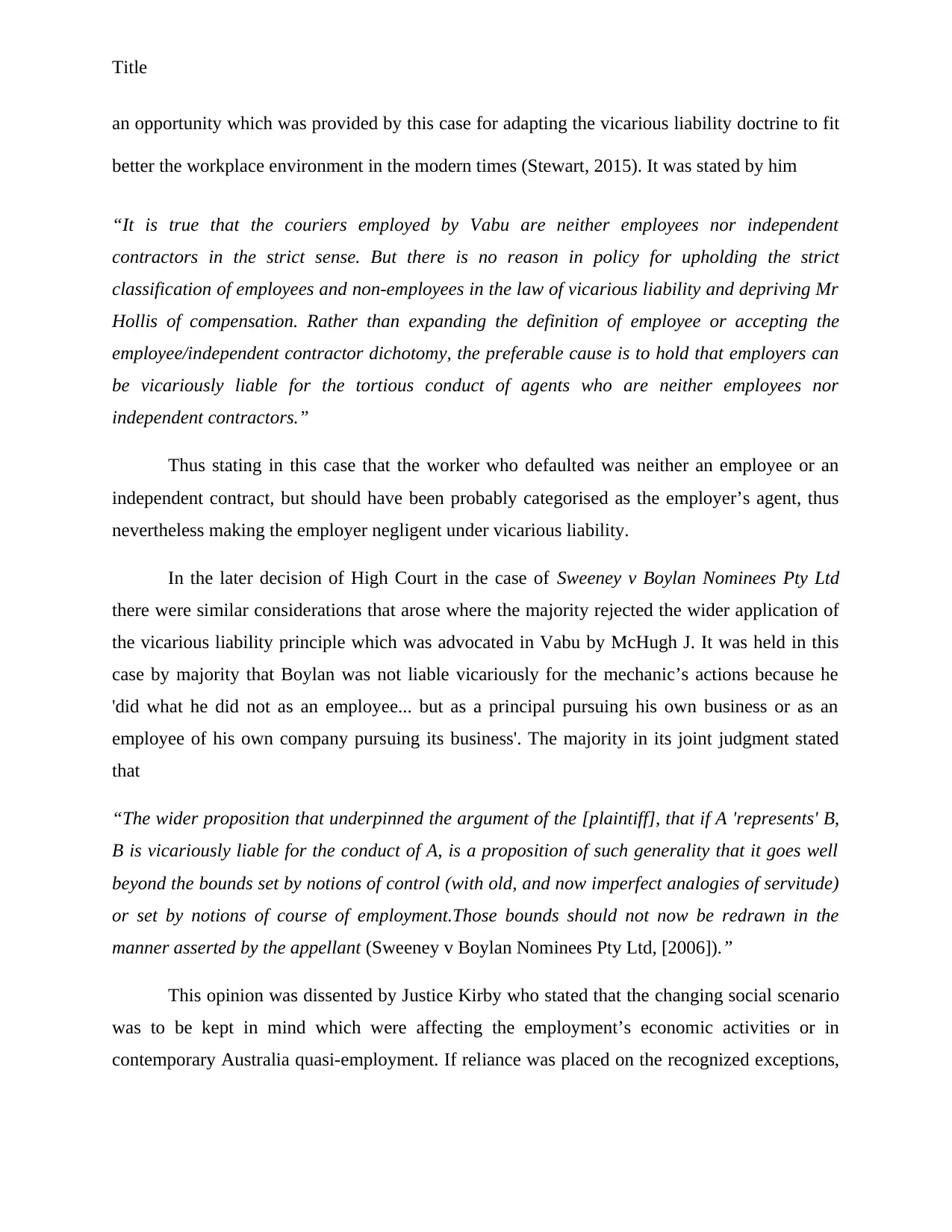
Title
an opportunity which was provided by this case for adapting the vicarious liability doctrine to fit
better the workplace environment in the modern times (Stewart, 2015). It was stated by him
“It is true that the couriers employed by Vabu are neither employees nor independent
contractors in the strict sense. But there is no reason in policy for upholding the strict
classification of employees and non-employees in the law of vicarious liability and depriving Mr
Hollis of compensation. Rather than expanding the definition of employee or accepting the
employee/independent contractor dichotomy, the preferable cause is to hold that employers can
be vicariously liable for the tortious conduct of agents who are neither employees nor
independent contractors.”
Thus stating in this case that the worker who defaulted was neither an employee or an
independent contract, but should have been probably categorised as the employer’s agent, thus
nevertheless making the employer negligent under vicarious liability.
In the later decision of High Court in the case of Sweeney v Boylan Nominees Pty Ltd
there were similar considerations that arose where the majority rejected the wider application of
the vicarious liability principle which was advocated in Vabu by McHugh J. It was held in this
case by majority that Boylan was not liable vicariously for the mechanic’s actions because he
'did what he did not as an employee... but as a principal pursuing his own business or as an
employee of his own company pursuing its business'. The majority in its joint judgment stated
that
“The wider proposition that underpinned the argument of the [plaintiff], that if A 'represents' B,
B is vicariously liable for the conduct of A, is a proposition of such generality that it goes well
beyond the bounds set by notions of control (with old, and now imperfect analogies of servitude)
or set by notions of course of employment.Those bounds should not now be redrawn in the
manner asserted by the appellant (Sweeney v Boylan Nominees Pty Ltd, [2006]).”
This opinion was dissented by Justice Kirby who stated that the changing social scenario
was to be kept in mind which were affecting the employment’s economic activities or in
contemporary Australia quasi-employment. If reliance was placed on the recognized exceptions,
an opportunity which was provided by this case for adapting the vicarious liability doctrine to fit
better the workplace environment in the modern times (Stewart, 2015). It was stated by him
“It is true that the couriers employed by Vabu are neither employees nor independent
contractors in the strict sense. But there is no reason in policy for upholding the strict
classification of employees and non-employees in the law of vicarious liability and depriving Mr
Hollis of compensation. Rather than expanding the definition of employee or accepting the
employee/independent contractor dichotomy, the preferable cause is to hold that employers can
be vicariously liable for the tortious conduct of agents who are neither employees nor
independent contractors.”
Thus stating in this case that the worker who defaulted was neither an employee or an
independent contract, but should have been probably categorised as the employer’s agent, thus
nevertheless making the employer negligent under vicarious liability.
In the later decision of High Court in the case of Sweeney v Boylan Nominees Pty Ltd
there were similar considerations that arose where the majority rejected the wider application of
the vicarious liability principle which was advocated in Vabu by McHugh J. It was held in this
case by majority that Boylan was not liable vicariously for the mechanic’s actions because he
'did what he did not as an employee... but as a principal pursuing his own business or as an
employee of his own company pursuing its business'. The majority in its joint judgment stated
that
“The wider proposition that underpinned the argument of the [plaintiff], that if A 'represents' B,
B is vicariously liable for the conduct of A, is a proposition of such generality that it goes well
beyond the bounds set by notions of control (with old, and now imperfect analogies of servitude)
or set by notions of course of employment.Those bounds should not now be redrawn in the
manner asserted by the appellant (Sweeney v Boylan Nominees Pty Ltd, [2006]).”
This opinion was dissented by Justice Kirby who stated that the changing social scenario
was to be kept in mind which were affecting the employment’s economic activities or in
contemporary Australia quasi-employment. If reliance was placed on the recognized exceptions,
⊘ This is a preview!⊘
Do you want full access?
Subscribe today to unlock all pages.

Trusted by 1+ million students worldwide
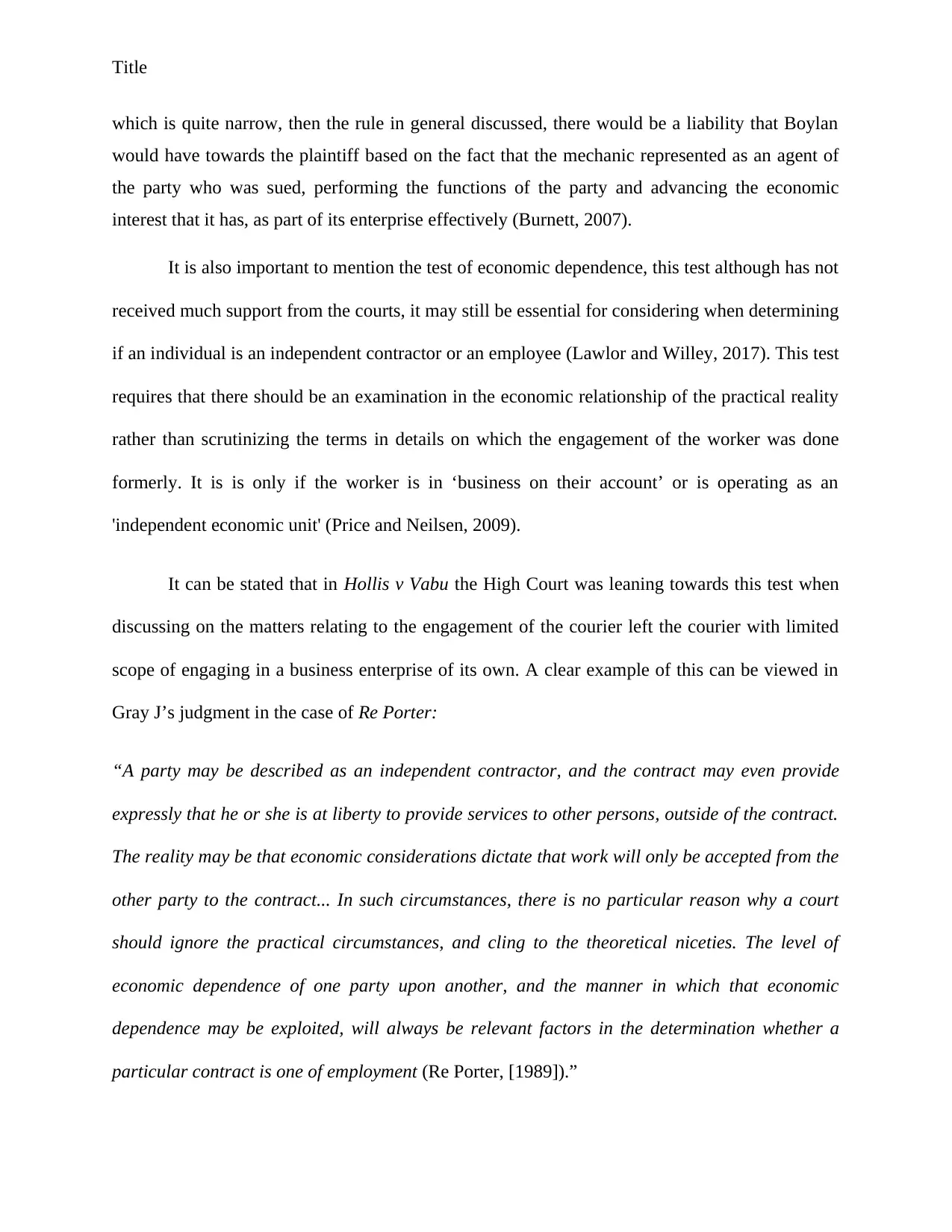
Title
which is quite narrow, then the rule in general discussed, there would be a liability that Boylan
would have towards the plaintiff based on the fact that the mechanic represented as an agent of
the party who was sued, performing the functions of the party and advancing the economic
interest that it has, as part of its enterprise effectively (Burnett, 2007).
It is also important to mention the test of economic dependence, this test although has not
received much support from the courts, it may still be essential for considering when determining
if an individual is an independent contractor or an employee (Lawlor and Willey, 2017). This test
requires that there should be an examination in the economic relationship of the practical reality
rather than scrutinizing the terms in details on which the engagement of the worker was done
formerly. It is is only if the worker is in ‘business on their account’ or is operating as an
'independent economic unit' (Price and Neilsen, 2009).
It can be stated that in Hollis v Vabu the High Court was leaning towards this test when
discussing on the matters relating to the engagement of the courier left the courier with limited
scope of engaging in a business enterprise of its own. A clear example of this can be viewed in
Gray J’s judgment in the case of Re Porter:
“A party may be described as an independent contractor, and the contract may even provide
expressly that he or she is at liberty to provide services to other persons, outside of the contract.
The reality may be that economic considerations dictate that work will only be accepted from the
other party to the contract... In such circumstances, there is no particular reason why a court
should ignore the practical circumstances, and cling to the theoretical niceties. The level of
economic dependence of one party upon another, and the manner in which that economic
dependence may be exploited, will always be relevant factors in the determination whether a
particular contract is one of employment (Re Porter, [1989]).”
which is quite narrow, then the rule in general discussed, there would be a liability that Boylan
would have towards the plaintiff based on the fact that the mechanic represented as an agent of
the party who was sued, performing the functions of the party and advancing the economic
interest that it has, as part of its enterprise effectively (Burnett, 2007).
It is also important to mention the test of economic dependence, this test although has not
received much support from the courts, it may still be essential for considering when determining
if an individual is an independent contractor or an employee (Lawlor and Willey, 2017). This test
requires that there should be an examination in the economic relationship of the practical reality
rather than scrutinizing the terms in details on which the engagement of the worker was done
formerly. It is is only if the worker is in ‘business on their account’ or is operating as an
'independent economic unit' (Price and Neilsen, 2009).
It can be stated that in Hollis v Vabu the High Court was leaning towards this test when
discussing on the matters relating to the engagement of the courier left the courier with limited
scope of engaging in a business enterprise of its own. A clear example of this can be viewed in
Gray J’s judgment in the case of Re Porter:
“A party may be described as an independent contractor, and the contract may even provide
expressly that he or she is at liberty to provide services to other persons, outside of the contract.
The reality may be that economic considerations dictate that work will only be accepted from the
other party to the contract... In such circumstances, there is no particular reason why a court
should ignore the practical circumstances, and cling to the theoretical niceties. The level of
economic dependence of one party upon another, and the manner in which that economic
dependence may be exploited, will always be relevant factors in the determination whether a
particular contract is one of employment (Re Porter, [1989]).”
Paraphrase This Document
Need a fresh take? Get an instant paraphrase of this document with our AI Paraphraser
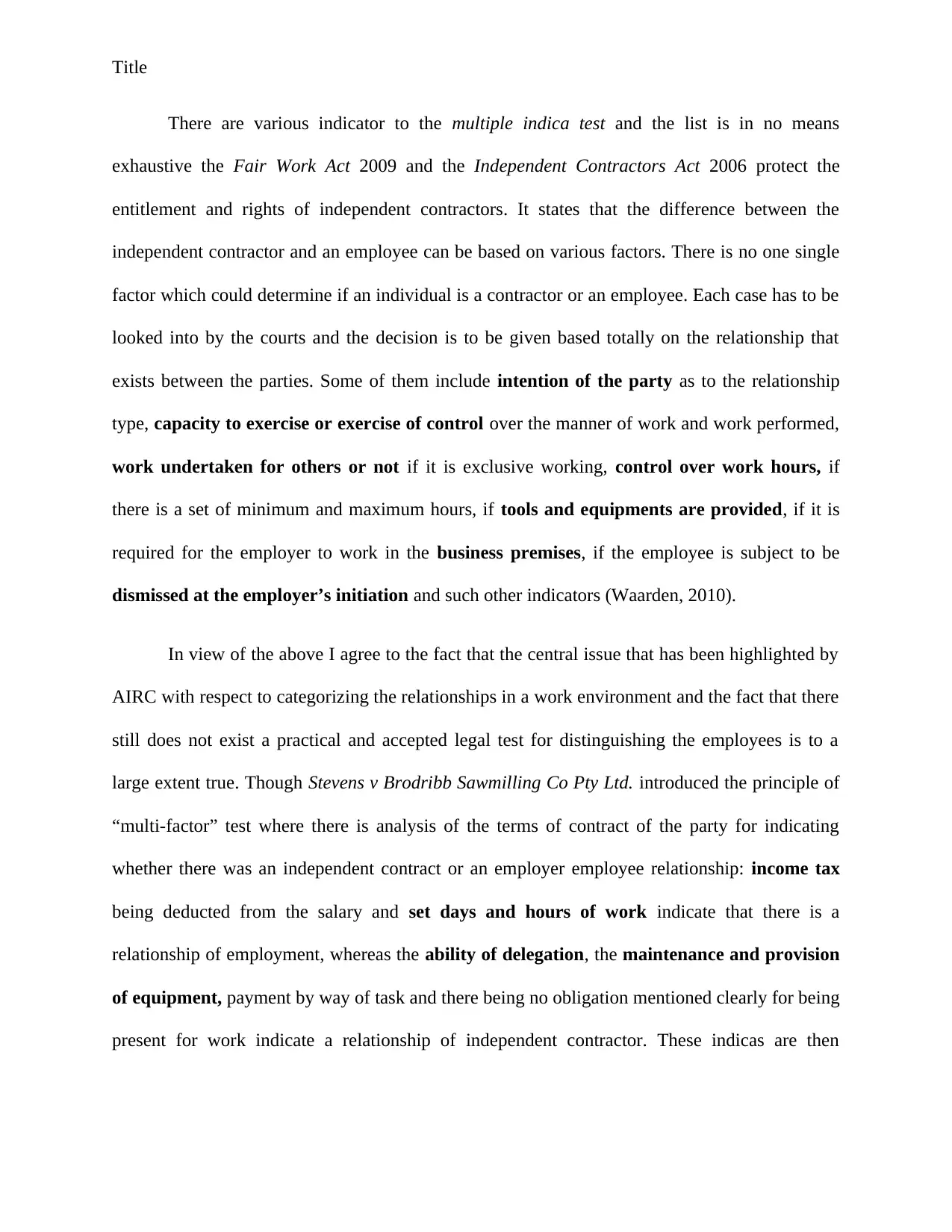
Title
There are various indicator to the multiple indica test and the list is in no means
exhaustive the Fair Work Act 2009 and the Independent Contractors Act 2006 protect the
entitlement and rights of independent contractors. It states that the difference between the
independent contractor and an employee can be based on various factors. There is no one single
factor which could determine if an individual is a contractor or an employee. Each case has to be
looked into by the courts and the decision is to be given based totally on the relationship that
exists between the parties. Some of them include intention of the party as to the relationship
type, capacity to exercise or exercise of control over the manner of work and work performed,
work undertaken for others or not if it is exclusive working, control over work hours, if
there is a set of minimum and maximum hours, if tools and equipments are provided, if it is
required for the employer to work in the business premises, if the employee is subject to be
dismissed at the employer’s initiation and such other indicators (Waarden, 2010).
In view of the above I agree to the fact that the central issue that has been highlighted by
AIRC with respect to categorizing the relationships in a work environment and the fact that there
still does not exist a practical and accepted legal test for distinguishing the employees is to a
large extent true. Though Stevens v Brodribb Sawmilling Co Pty Ltd. introduced the principle of
“multi-factor” test where there is analysis of the terms of contract of the party for indicating
whether there was an independent contract or an employer employee relationship: income tax
being deducted from the salary and set days and hours of work indicate that there is a
relationship of employment, whereas the ability of delegation, the maintenance and provision
of equipment, payment by way of task and there being no obligation mentioned clearly for being
present for work indicate a relationship of independent contractor. These indicas are then
There are various indicator to the multiple indica test and the list is in no means
exhaustive the Fair Work Act 2009 and the Independent Contractors Act 2006 protect the
entitlement and rights of independent contractors. It states that the difference between the
independent contractor and an employee can be based on various factors. There is no one single
factor which could determine if an individual is a contractor or an employee. Each case has to be
looked into by the courts and the decision is to be given based totally on the relationship that
exists between the parties. Some of them include intention of the party as to the relationship
type, capacity to exercise or exercise of control over the manner of work and work performed,
work undertaken for others or not if it is exclusive working, control over work hours, if
there is a set of minimum and maximum hours, if tools and equipments are provided, if it is
required for the employer to work in the business premises, if the employee is subject to be
dismissed at the employer’s initiation and such other indicators (Waarden, 2010).
In view of the above I agree to the fact that the central issue that has been highlighted by
AIRC with respect to categorizing the relationships in a work environment and the fact that there
still does not exist a practical and accepted legal test for distinguishing the employees is to a
large extent true. Though Stevens v Brodribb Sawmilling Co Pty Ltd. introduced the principle of
“multi-factor” test where there is analysis of the terms of contract of the party for indicating
whether there was an independent contract or an employer employee relationship: income tax
being deducted from the salary and set days and hours of work indicate that there is a
relationship of employment, whereas the ability of delegation, the maintenance and provision
of equipment, payment by way of task and there being no obligation mentioned clearly for being
present for work indicate a relationship of independent contractor. These indicas are then
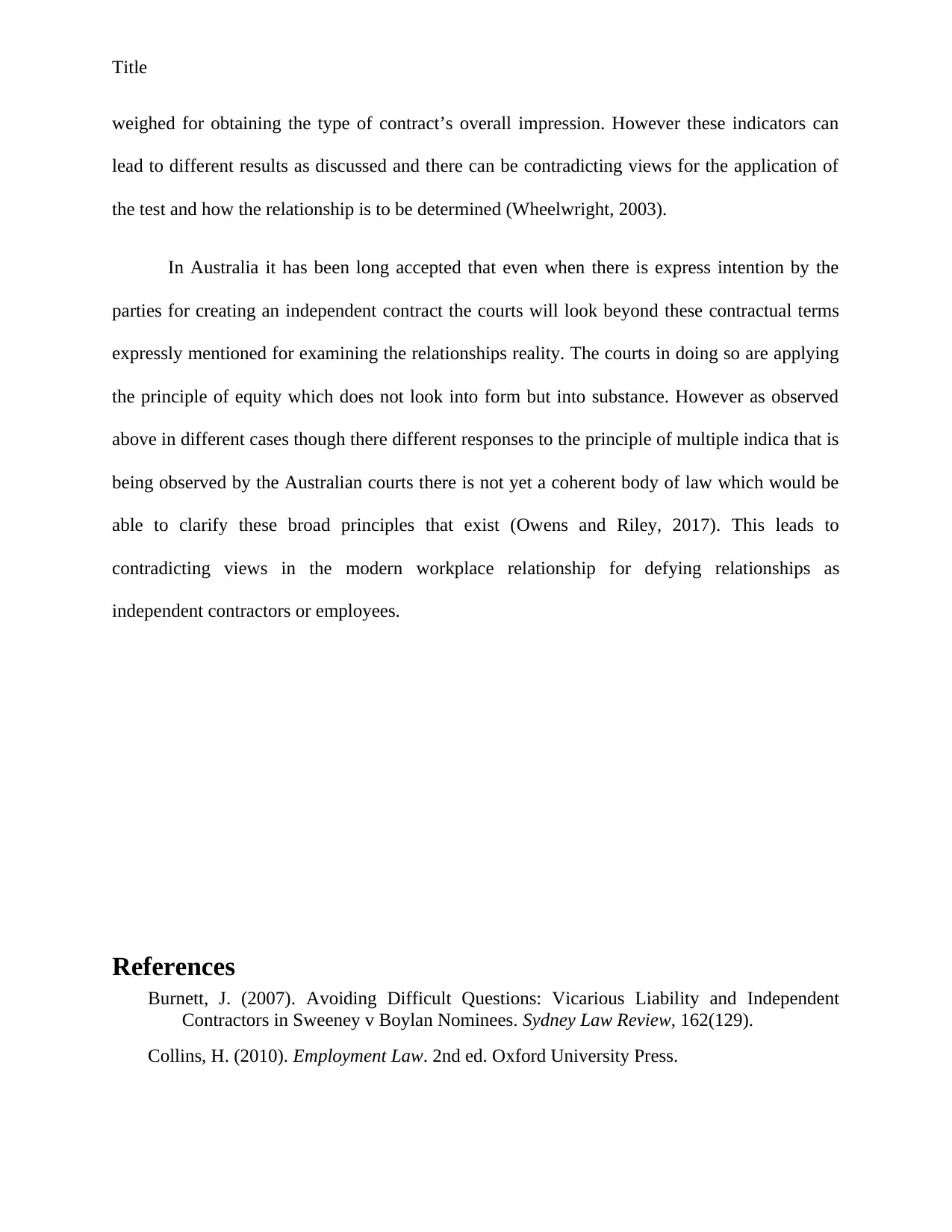
Title
weighed for obtaining the type of contract’s overall impression. However these indicators can
lead to different results as discussed and there can be contradicting views for the application of
the test and how the relationship is to be determined (Wheelwright, 2003).
In Australia it has been long accepted that even when there is express intention by the
parties for creating an independent contract the courts will look beyond these contractual terms
expressly mentioned for examining the relationships reality. The courts in doing so are applying
the principle of equity which does not look into form but into substance. However as observed
above in different cases though there different responses to the principle of multiple indica that is
being observed by the Australian courts there is not yet a coherent body of law which would be
able to clarify these broad principles that exist (Owens and Riley, 2017). This leads to
contradicting views in the modern workplace relationship for defying relationships as
independent contractors or employees.
References
Burnett, J. (2007). Avoiding Difficult Questions: Vicarious Liability and Independent
Contractors in Sweeney v Boylan Nominees. Sydney Law Review, 162(129).
Collins, H. (2010). Employment Law. 2nd ed. Oxford University Press.
weighed for obtaining the type of contract’s overall impression. However these indicators can
lead to different results as discussed and there can be contradicting views for the application of
the test and how the relationship is to be determined (Wheelwright, 2003).
In Australia it has been long accepted that even when there is express intention by the
parties for creating an independent contract the courts will look beyond these contractual terms
expressly mentioned for examining the relationships reality. The courts in doing so are applying
the principle of equity which does not look into form but into substance. However as observed
above in different cases though there different responses to the principle of multiple indica that is
being observed by the Australian courts there is not yet a coherent body of law which would be
able to clarify these broad principles that exist (Owens and Riley, 2017). This leads to
contradicting views in the modern workplace relationship for defying relationships as
independent contractors or employees.
References
Burnett, J. (2007). Avoiding Difficult Questions: Vicarious Liability and Independent
Contractors in Sweeney v Boylan Nominees. Sydney Law Review, 162(129).
Collins, H. (2010). Employment Law. 2nd ed. Oxford University Press.
⊘ This is a preview!⊘
Do you want full access?
Subscribe today to unlock all pages.

Trusted by 1+ million students worldwide
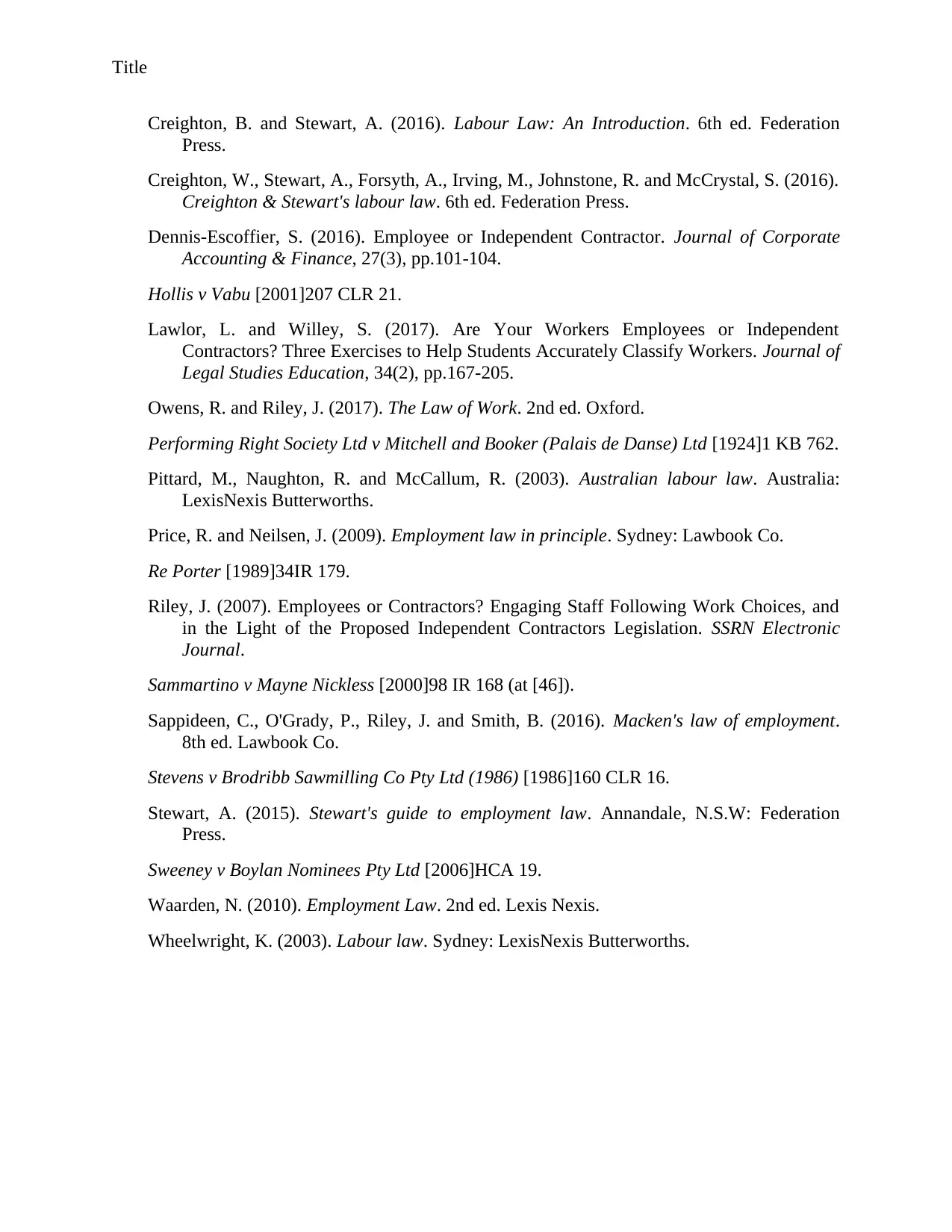
Title
Creighton, B. and Stewart, A. (2016). Labour Law: An Introduction. 6th ed. Federation
Press.
Creighton, W., Stewart, A., Forsyth, A., Irving, M., Johnstone, R. and McCrystal, S. (2016).
Creighton & Stewart's labour law. 6th ed. Federation Press.
Dennis-Escoffier, S. (2016). Employee or Independent Contractor. Journal of Corporate
Accounting & Finance, 27(3), pp.101-104.
Hollis v Vabu [2001]207 CLR 21.
Lawlor, L. and Willey, S. (2017). Are Your Workers Employees or Independent
Contractors? Three Exercises to Help Students Accurately Classify Workers. Journal of
Legal Studies Education, 34(2), pp.167-205.
Owens, R. and Riley, J. (2017). The Law of Work. 2nd ed. Oxford.
Performing Right Society Ltd v Mitchell and Booker (Palais de Danse) Ltd [1924]1 KB 762.
Pittard, M., Naughton, R. and McCallum, R. (2003). Australian labour law. Australia:
LexisNexis Butterworths.
Price, R. and Neilsen, J. (2009). Employment law in principle. Sydney: Lawbook Co.
Re Porter [1989]34IR 179.
Riley, J. (2007). Employees or Contractors? Engaging Staff Following Work Choices, and
in the Light of the Proposed Independent Contractors Legislation. SSRN Electronic
Journal.
Sammartino v Mayne Nickless [2000]98 IR 168 (at [46]).
Sappideen, C., O'Grady, P., Riley, J. and Smith, B. (2016). Macken's law of employment.
8th ed. Lawbook Co.
Stevens v Brodribb Sawmilling Co Pty Ltd (1986) [1986]160 CLR 16.
Stewart, A. (2015). Stewart's guide to employment law. Annandale, N.S.W: Federation
Press.
Sweeney v Boylan Nominees Pty Ltd [2006]HCA 19.
Waarden, N. (2010). Employment Law. 2nd ed. Lexis Nexis.
Wheelwright, K. (2003). Labour law. Sydney: LexisNexis Butterworths.
Creighton, B. and Stewart, A. (2016). Labour Law: An Introduction. 6th ed. Federation
Press.
Creighton, W., Stewart, A., Forsyth, A., Irving, M., Johnstone, R. and McCrystal, S. (2016).
Creighton & Stewart's labour law. 6th ed. Federation Press.
Dennis-Escoffier, S. (2016). Employee or Independent Contractor. Journal of Corporate
Accounting & Finance, 27(3), pp.101-104.
Hollis v Vabu [2001]207 CLR 21.
Lawlor, L. and Willey, S. (2017). Are Your Workers Employees or Independent
Contractors? Three Exercises to Help Students Accurately Classify Workers. Journal of
Legal Studies Education, 34(2), pp.167-205.
Owens, R. and Riley, J. (2017). The Law of Work. 2nd ed. Oxford.
Performing Right Society Ltd v Mitchell and Booker (Palais de Danse) Ltd [1924]1 KB 762.
Pittard, M., Naughton, R. and McCallum, R. (2003). Australian labour law. Australia:
LexisNexis Butterworths.
Price, R. and Neilsen, J. (2009). Employment law in principle. Sydney: Lawbook Co.
Re Porter [1989]34IR 179.
Riley, J. (2007). Employees or Contractors? Engaging Staff Following Work Choices, and
in the Light of the Proposed Independent Contractors Legislation. SSRN Electronic
Journal.
Sammartino v Mayne Nickless [2000]98 IR 168 (at [46]).
Sappideen, C., O'Grady, P., Riley, J. and Smith, B. (2016). Macken's law of employment.
8th ed. Lawbook Co.
Stevens v Brodribb Sawmilling Co Pty Ltd (1986) [1986]160 CLR 16.
Stewart, A. (2015). Stewart's guide to employment law. Annandale, N.S.W: Federation
Press.
Sweeney v Boylan Nominees Pty Ltd [2006]HCA 19.
Waarden, N. (2010). Employment Law. 2nd ed. Lexis Nexis.
Wheelwright, K. (2003). Labour law. Sydney: LexisNexis Butterworths.
1 out of 10
Related Documents
Your All-in-One AI-Powered Toolkit for Academic Success.
+13062052269
info@desklib.com
Available 24*7 on WhatsApp / Email
![[object Object]](/_next/static/media/star-bottom.7253800d.svg)
Unlock your academic potential
Copyright © 2020–2025 A2Z Services. All Rights Reserved. Developed and managed by ZUCOL.





